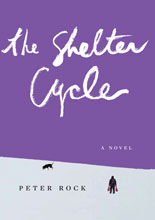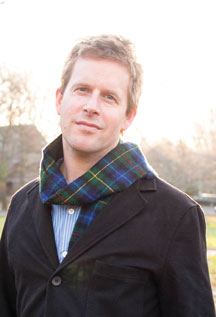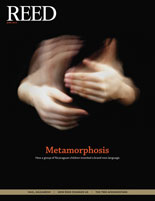
IRIS login | Reed College home Volume 92, No. 2: June 2013
Reediana
The Shelter Cycle (Houghton Mifflin Harcourt, 2013)
Peter Rock [English 2001–]
By Angie Jabine ’79

Supernatural forces, both menacing and benevolent, gust through this meticulously constructed novel based on the real-life sect known as the Church Universal and Triumphant. When Elizabeth Clare Prophet, the church’s leader, predicted a nuclear holocaust would come in 1990, her followers built a huge complex of underground shelters in Montana’s Paradise Valley. The predicted Doomsday fizzled, and Prophet eventually succumbed to Alzheimer’s disease, but the shelters have survived, and the religion still has adherents.
In his sixth novel, Peter Rock reunites two childhood friends 20 years after the calamity that never came. Francine is married, seven months pregnant, and living in Boise. News cameras swarm her street as she joins her neighbors in the search for a missing nine-year-old girl. Her thoughts are filled with memories of her childhood and the spirits she used to believe in—Undines, Salamanders, Gnomes, Sylphs. At this fraught moment, Colville, a wisp of a man, appears on Francine’s doorstep.
Colville has recently lost his younger brother to a roadside bombing in Afghanistan. Just as impending motherhood has shaken loose Francine’s childhood memories, Colville’s own loss has dislodged something within his psyche. Haltingly, he describes to Francine and her husband the signs and portents that have led him to Boise, where he believes he is destined to rescue the lost girl. But Colville’s mission changes from moment to moment, and Francine’s husband has every reason to mistrust him.
In the presence of outsiders, both Francine and Colville are taciturn about their unorthodox past. Rock sparingly and offhandedly metes out bits of crucial information—how Francine’s parents died, how Colville’s parents drifted away. Francine feels the failed apocalypse as a loss. “All the work and then all the years after, would feel different . . . if the bombs had come,” she thinks. “And then her parents might still be alive.”
Neither Francine nor Colville can make sense of their past until they can once again crawl into the fallout shelters, with their comforting mazes of bunk beds, classrooms, kitchens, and shrines. For Francine, the trip marks a final farewell to her childhood, however extraordinary. But the visit launches Colville on a stark vision quest that will keep readers guessing beyond the final page.


LATEST COMMENTS
steve-jobs-1976 I knew Steve Jobs when he was on the second floor of Quincy. (Fall...
Utnapishtim - 2 weeks ago
Prof. Mason Drukman [political science 1964–70] This is gold, pure gold. God bless, Prof. Drukman.
puredog - 1 month ago
virginia-davis-1965 Such a good friend & compatriot in the day of Satyricon...
czarchasm - 4 months ago
John Peara Baba 1990 John died of a broken heart from losing his mom and then his...
kodachrome - 7 months ago
Carol Sawyer 1962 Who wrote this obit? I'm writing something about Carol Sawyer...
MsLaurie Pepper - 8 months ago
William W. Wissman MAT 1969 ...and THREE sisters. Sabra, the oldest, Mary, the middle, and...
riclf - 10 months ago